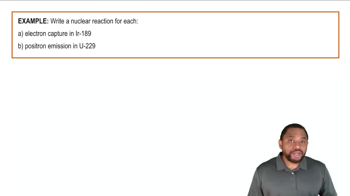Americium-241 is used in smoke detectors. It has a first-order rate constant for radioactive decay of k = 1.6 * 10-3 yr-1. By contrast, iodine-125, which is used to test for thyroid functioning, has a rate constant for radioactive decay of k = 0.011 day-1. (c) How much of a 1.00-mg sample of each isotope remains after three half-lives?
Ch.14 - Chemical Kinetics
Chapter 14, Problem 101d
The rate of a first-order reaction is followed by spectroscopy, monitoring the absorbance of a colored reactant at 520 nm. The reaction occurs in a 1.00-cm sample cell, and the only colored species in the reaction has an extinction coefficient of 5.60 * 103 M-1 cm-1 at 520 nm. (d) How long does it take for the absorbance to fall to 0.100?
 Verified step by step guidance
Verified step by step guidance1
Identify the relationship between absorbance and concentration using Beer's Law: \( A = \varepsilon c l \), where \( A \) is absorbance, \( \varepsilon \) is the extinction coefficient, \( c \) is the concentration, and \( l \) is the path length.
Since the reaction is first-order, use the first-order kinetics equation: \( \ln \left( \frac{[A]_0}{[A]} \right) = kt \), where \([A]_0\) is the initial concentration, \([A]\) is the concentration at time \( t \), and \( k \) is the rate constant.
Relate the initial and final absorbance to concentration using Beer's Law: \( A_0 = \varepsilon [A]_0 l \) and \( A = \varepsilon [A] l \).
Substitute the expressions for \([A]_0\) and \([A]\) from Beer's Law into the first-order kinetics equation: \( \ln \left( \frac{A_0}{A} \right) = kt \).
Solve for \( t \) using the given values: \( A_0 \) (initial absorbance), \( A = 0.100 \), and the calculated rate constant \( k \).

Verified Solution
Video duration:
5mWas this helpful?
Key Concepts
Here are the essential concepts you must grasp in order to answer the question correctly.
First-Order Reaction Kinetics
First-order reactions are characterized by a rate that is directly proportional to the concentration of one reactant. The rate law for a first-order reaction can be expressed as rate = k[A], where k is the rate constant and [A] is the concentration of the reactant. The integrated rate law for such reactions allows us to relate concentration and time, which is essential for calculating how long it takes for the absorbance to change.
Recommended video:
Guided course

First-Order Reactions
Beer-Lambert Law
The Beer-Lambert Law describes the relationship between absorbance (A), concentration (c), and path length (l) in a solution, expressed as A = εcl. Here, ε is the molar absorptivity or extinction coefficient. This law is crucial for determining the concentration of the colored reactant from its absorbance at a specific wavelength, allowing us to track the progress of the reaction over time.
Recommended video:
Guided course

Hess's Law
Extinction Coefficient
The extinction coefficient (ε) is a measure of how strongly a chemical species absorbs light at a given wavelength, expressed in units of M^-1 cm^-1. In this context, it quantifies the absorbance of the colored reactant at 520 nm, enabling the calculation of concentration changes as the reaction proceeds. Understanding this coefficient is vital for applying the Beer-Lambert Law to determine how long it takes for the absorbance to reach a specified value.
Recommended video:
Guided course

Electron Capture & Positron Emission Reaction Example
Related Practice
Textbook Question
1042
views
Textbook Question
The rate of a first-order reaction is followed by spectroscopy, monitoring the absorbance of a colored reactant at 520 nm. The reaction occurs in a 1.00-cm sample cell, and the only colored species in the reaction has an extinction coefficient of 5.60 * 103 M-1 cm-1 at 520 nm. (a) Calculate the initial concentration of the colored reactant if the absorbance is 0.605 at the beginning of the reaction.
304
views
Textbook Question
The rate of a first-order reaction is followed by spectroscopy, monitoring the absorbance of a colored reactant at 520 nm. The reaction occurs in a 1.00-cm sample cell, and the only colored species in the reaction has an extinction coefficient of 5.60 * 103 M-1 cm-1 at 520 nm. (c) Calculate the half-life of the reaction.
370
views
Open Question
A colored dye compound decomposes to give a colorless product. The original dye absorbs at 608 nm and has an extinction coefficient of 4.7 * 10^4 M^-1 cm^-1 at that wavelength. You perform the decomposition reaction in a 1-cm cuvette in a spectrometer and obtain the following data: Time (min) Absorbance at 608 nm 0 1.254 30 0.941 60 0.752 90 0.672 120 0.545. From these data, determine the rate law for the reaction 'dye → product' and determine the rate constant.
Open Question
Cyclopentadiene (C5H6) reacts with itself to form dicyclopentadiene (C10H12). A 0.0400 M solution of C5H6 was monitored as a function of time as the reaction 2 C5H6 → C10H12 proceeded. The following data were collected: Time (s) | [C5H6] (M) 0.0 | 0.0400 50.0 | 0.0300 100.0 | 0.0240 150.0 | 0.0200 200.0 | 0.0174 Plot [C5H6] versus time, ln[C5H6] versus time, and 1/[C5H6] versus time. (b) What is the value of the rate constant?
Open Question
The first-order rate constant for the reaction of a particular organic compound with water varies with temperature as follows: Temperature (K) Rate Constant (s⁻¹) 300 3.2 × 10⁻¹¹, 320 1.0 × 10⁻⁹, 340 3.0 × 10⁻⁸, 355 2.4 × 10⁻⁷. From these data, calculate the activation energy in units of kJ/mol.
